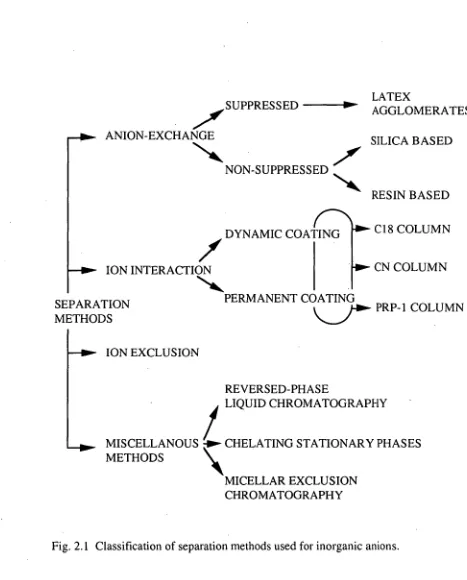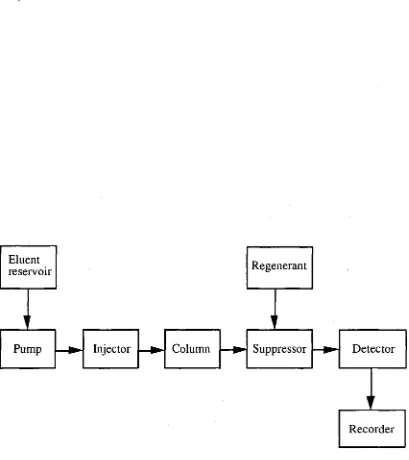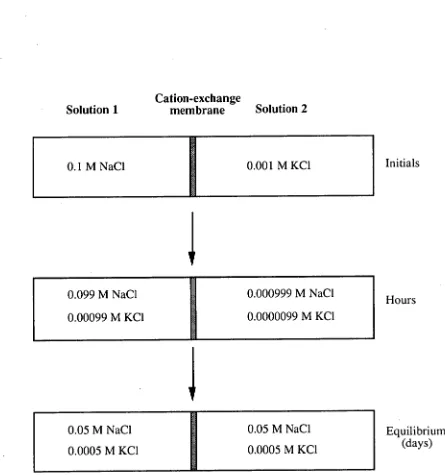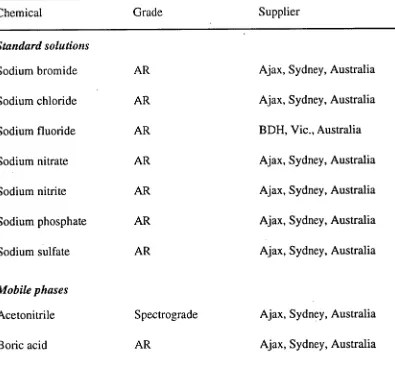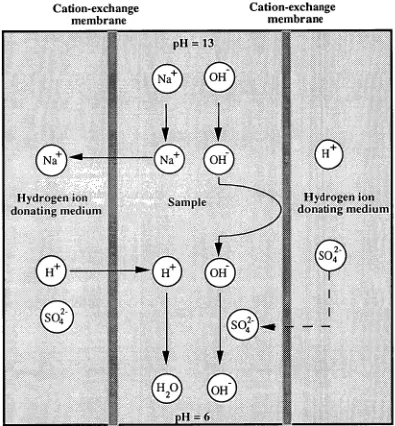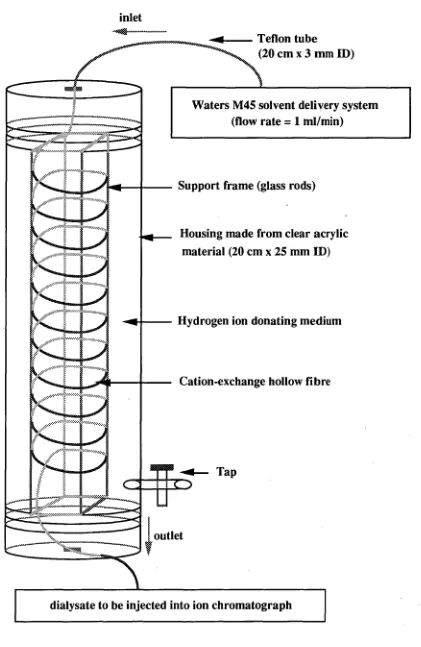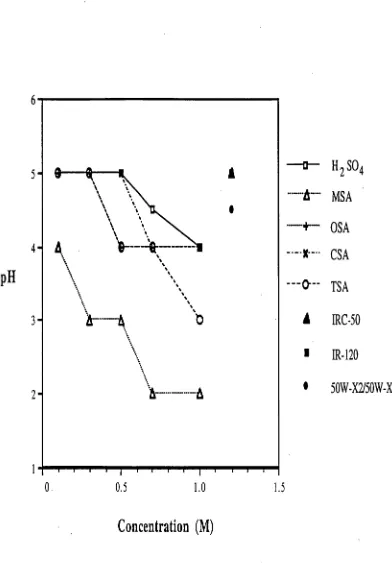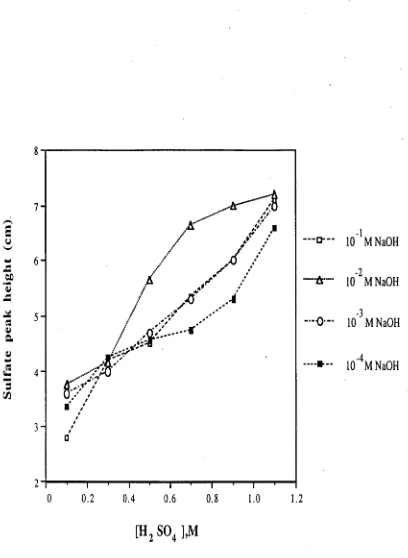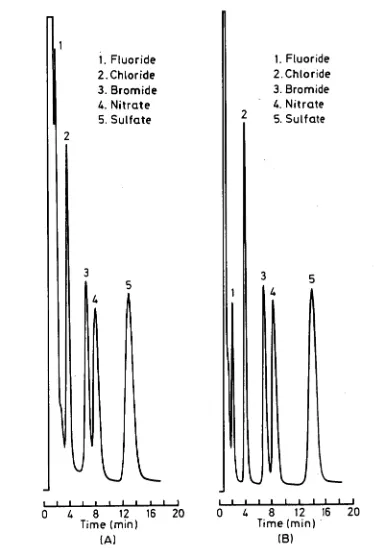DIALYTIC METHODS FOR SAMPLE TREATMENT
IN ION CHROMATOGRAPHY
by
SOEHENDRA LAKSANA B. Sc., M. Chem.
Submitted in fulfilment of the requirements for the degree of
Doctor of Philosophy
Department of Chemistry University of Tasmania
Hobart, Australia
I hereby declare that this submission is my own work and that, to the best of my knowledge and belief, it contains no material previously published or written by another person nor material which to a substantial extent has been accepted for the
)
award of any other degree or diploma of a university or other institute of higher learning, except where due acknowledgment is m�de in the text.
·
ABSTRACT
This thesis presents the results of a systematic study of the parameters affecting dialysis procedures, including active (Donnan) dialysis and electrodialysis, for the pretreatment of alkaline samples prior to ion chromatographic analysis. A preliminary study of enrichment of inorganic anions using an "Elutrap" apparatus is also presented. Dialysis methods were investigated with a view to applying membrane-based clean-up procedures to the determination of trace levels of inorganic anions in various samples following sample treatment by hydroxide fusion.
Donnan dialysis was carried out by passing sodium hydroxide solutions containing inorganic anions through a cation-exchange hollow fibre immersed in a hydrogen ion donating medium. As the sample is passed through the lumen of the fibre, a dialysis reaction involving exchange of sodium ions in the sample with hydrogen ions from the surrounding medium occurs, resulting in total or partial neutralization of the sample. Several acid solutions including slurries of cation-exchange resins were evaluated on the basis of neutralization efficiency and penetration of the acid anion through the membrane. Cation-exchange resins in the hydrogen form slurried with 0.1 M octanesulfonic acid gave optimal performance and when the resin was stirred occasionally the total theoretical neutralization capacity of the resin was achieved.
SO42- in the range 3-10 lig/m1) from 1 M NaOH solution were close to quantitative except for fluoride and nitrite. It is suggested that low recoveries for these ions were due to the formation of neutral, protonated species within the membrane with subsequent loss by diffusion.
A flow-through electrodialysis device, in which the sample was allowed to flow during the dialysis process, was studied for the on-line pretreatment of strongly alkaline solutions. Variations of the shape of the sample compartments and the size of the electrodes were studied in order to optimize the flow-through cell design and to minimize the heat generated inside the cell. Quantitative recovery for fluoride ion could be achieved using a Neosepta CMS cation-exchange membrane and the ability to successfully treat samples containing fluoride represented an improvement over the off-line cell.
ACKNOWLEDGEMENTS
During the three and a half years that it has taken to complete this thesis, many people both in University of New South Wales, where I spent the first two years of this work, and in University of Tasmania have contributed their time and support toward the completion of this project. I would like to express my sincere gratitude and appreciation to all those who have helped me along the way, and in particular the following people:
Paul Haddad, my supervisor, for the opportunity to pursue this project, his support, guidance and friendship over the years.
Ray Simons at the School of Physics, University of New South Wales, my co-supervisor, for his assistance and advice.
The staff members of the Department of Chemistry, University of Tasmania, especially Peter Dove and John Davis for their assistance in the construction of the flow-through electrodialysis device.
The staff members of the School of Chemistry, University of New South Wales, for their help that made this work possible.
My fellow "Chromatography group" research students both in UTas and in UNSW over the past few years: Andrew, Peter, Frank, Tony, Sarah, Christine, Jim, Ofelia, Tuti, Ada, Joselyn, Terry Flynn at the Centre for Chemical Analysis for their warm friendship and Simon for his help in generating the CE results.
1. Dialytic Clean-up of Alkaline Samples Priorto Ion Chromatographic Analysis. - Soehendra Laksana and Paul R. Haddad
- Journal of Chromatography, 602 (1992) 57. (Work from Chapter Four ofthe Thesis)
2. Electrodialysis for Clean-up of Strongly Alkaline Samples in Ion Chromatography.
- Paul R. Haddad, Soehendra Laksana and Ray G. Simons. - Journal of Chromatography, 640 (1993) 135.
(Work from Chapter Six ofthe Thesis)
3. Ion Chromatography of Strongly Alkaline Samples. - Soehendra Laksana and Paul R. Haddad.
- Chemistryin Australia, 59 (1992) 282. (Work from Chapter Six ofthe Thesis)
4. Ion Chromatographic Analysis of Alkaline Samples Using an On-line Electrodialysis Device.
- Soehendra Laksana and Paul R. Haddad. - Chemistryin Australia, 60 (1993) 276. (Work from Chapter Seven ofthe Thesis)
5. On-line Pretreatment of Alkaline Samples Using a Flow-through Electrodialysis Device.
- Soehendra Laksana, Paul R. Haddad and Ray G. Simons. - paperin preparation.
LIST
OF
PRESENTATIONS
FROM
THIS
THESIS
1. Dialytic Methods forthe Clean-up of Alkaline Sample Solutions Priorto Ion Chromatographic Analysis.
- Soehendra Laksana and Paul R. Haddad.
- A paper presented at International Ion Chromatography Symposium, October 1991, Denver, USA. Abstract no. 28.
(Work from Chapter Four ofthe Thesis)
2. A Study of Dialysis Treatments forthe Clean-up of Alkaline Sample Solutions Priorto Ion Chromatographic Analysis.
- Soehendra Laksana and Paul R. Haddad
- A poster presented atthe 1 1th Australian Symposium on Analytical Chemistry, July 1991, Hobart, Australia. Abstract no. 134.
(Work from Chapter Four ofthe Thesis)
3. Electrodialysis of Alkaline Samples Priorto Ion Chromatographic Analysis. - Soehendra Laksana and Paul R. Haddad.
- A paper presented at International Ion Chromatography Symposium, September 1992, Linz, Austria. Abstract no. 3.
(Work from Chapter Six ofthe Thesis)
On-line Pretreatment of Alkaline Samples Using a Flow-through Electrodialysis Device.
- Soehendra Laksana, Paul R. Haddad and Ray G. Simons.
- A paper will be presented at International Ion Chromatography Symposium, September 1993, Baltimore, USA.
(Work from Chapter Seven ofthe Thesis)
5. Electrodialysis of Alkaline Samples Priorto Ion Chromatographic Analysis. - Paul R. Haddad, Soehendra Laksana and Ray G. Simons.
- A paper will be presented atthe 12th Australian Symposium on Analytical Chemistry, October 1993, Perth, Australia.
Chapter
one
INTRODUCTION 1
Chapter
two
LITERATURE REVIEW
2
.1
INTRODUCTION •5
2
.2
SEPARATION METHODS7
2
.2
.1
INTRODUCTION7
2
.2
.2
ANION-EXCHANGE METHODS7
2
.2
.2
.1
Supp
ressed
ion
ch
roma
tog
raphy
7
2
.2
.2
.2
Non
-supp
ressed
ion
ch
roma
tog
raphy
14
2
.2
.3
ION-INTERACTION METHODS16
2
.2
.4
ION-EXCLUSION METHODS18
2
.2
.5
MISCELLANEOUS SEPARATION METHODS20
2
.3
DETECTION METHODS22
2
.3
.1
INTRODUCTION22
2
.3
.2
CONDUCTIVITY DETECTION22
2
.3
.3
ELECTROCHEMICAL DETECTION25
2
.3
.4
SPECTROSCOPIC DETECTION26
2
.3
.5
POST-COLUMN REACTION DETECTION29
2
.4
SAMPLE CLEAN-UP METHODS30
2
.4
.1
INTRODUCTION30
2
.4
.2
FILTRATION AND SOLID-PHASE EXTRACTION31
2
.4
.3
DIALYSIS32
2
.4
.3
.1
D
ia
ly
t
ic
techn
iques
in
ion
ch
roma
tog
raphy
36
2
.4
.3
.2
Memb
ranes
used
fo
r
d
ia
lys
is
41
2
.4
.3
.2
.1
In
t
roduc
t
ion
41
2
.4
.3
.2
.2
S
t
ruc
tu
re
and
p
rope
r
t
ies
o
f
memb
ranes
43
2
.4
.3
.2
.3
Ion
-exchange
memb
ranes
44
Chapter three
EXPERIMENTAL
3.1 INTRODUCTION 56
3.2 INSTRUMENTATION AND APPARATUS 56 3.3 REAGENTS AND PROCEDURES 60 3.3.1ELUENT PREPARATION 60
3.3.2STANDARD SOLUTIONS 60
3.3.3REAGENTS 61
3.3.4CHROMATOGRAPHIC PROCEDURES 63
3.4 REFERENCES 64
Chapter four
DONNA N-DIALYTIC CLEAN-UP OF ALKALINE SAMPLES PRIOR TO ION CHROMATOGRAPHIC ANALYSIS
4.1 INTRODUCTION 65
4.2 EXPERIMENTAL 69
4.2.1INSTRUMENTATION 69
4.2.2DIALYSIS DEVICES 70
4.2.3REAGENTS 73
4.2.3.1 Standard solutions 73 4.2.3.2 Hydrogenion donating media 73
4.2.4PROCEDURES 75
4.2.4.1 Comparison of hydrogenion donating media 75 4.2.4.2 Comparison offibretypes 76 4.2.4.3 Neutralization capacity of dialysis device 76 4.3 RESULTS AND DISCUSSION 77 4.3.1COMPARISON OF HYDROGEN ION DONATING MEDIA 77
4.3.2COMPARISON OF FIBRE TYPES 92
4.3.3NEUTRALIZATION CAPACITY OF THE DIALYSIS DEVICE 98
4.4 CONCLUSIONS 103
A STUDY OF ELECTROMIGRATION OF INORGANIC ANIONS USING AN "ELUTRAP" APPARATUS
5.1 INTRODUCTION 104
5.2 EXPERIMENTAL 107
5.2.1INSTRUMENTATION 107
5.2.2REAGENTS AND STANDARD SOLUTIONS 108
5.2.3PROCEDURES 108
5.3 RESULTS AND DISCUSSION 109 5.3.1EFFECT OF APPLIED POTENTIAL 109 5.3.2EFFECT OF THE ARRANGEMENT OF THE MEMBRANES 119
5.4 CONCLUSIONS 123
5.5 REFERENCES 124
Chapter six
OFF-LINE ELECTRODIALYSIS FOR CLEAN-UP OF STRONGLY ALKALINE SAMPLES IN ION CHROMATOGRAPHY
6.1 INTRODUCTION 125
6.2 EXPERIMENTAL 129
6.2.1INSTRUMENTATION 129
6.2.2ELECTRODIALYSIS DEVICE 129
6.2.3REAGENTS 131
6.2.3.1 Standard solutions 132 6.2.3.2 Hydrogenion donating media 132 6.2.4CATION-EXCHANGE MEMBRANES 133
6.2.5PROCEDURES 133
6.3 RESULTS AND DISCUSSION 134 6.3.1SELECTION OF ELECTRODIALYSIS CONDITIONS 134
6.3.2CELL DESIGN 138
6.3.3SELECTION OF THE MEMBRANE 141 6.3.4SELECTION OF HYDROGEN ION DONATING MEDIUM 154
6.4 CONCLUSIONS 158
Chapter seven
ON-LINE PRETREATMENT OF ALKALINE SAMPLES USING A FLOW-THROUGH ELECTRODIALYSIS DEVICE
7
.1
INTRODUCTION
160
7
.2
EXPERIMENTAL
161
7
.2
.1
INSTRUMENTATION161
7
.2
.2
FLOW-THROUGH ELECTRODIALYSIS DEVICE162
7
.2
.3
REAGENTS164
7
.2
.4
PROCEDURES165
7
.2
.4
.1
Op
t
im
iza
t
ion
o
f
the
des
ign
o
f
the
f
low
-
th
rough
e
lec
t
rod
ia
lys
is
dev
ice
165
7
.2
.4
.2
De
te
rm
ina
t
ion
o
f
f
luo
r
ide
in
fo
rage
vege
ta
t
ion
samp
les
ob
ta
ined
f
rom
the
v
ic
in
i
ty
o
f
an
a
lum
in
ium
sme
l
te
r
165
7
.2
.4
.3
De
te
rm
ina
t
ion
o
f
f
luo
r
ide
and
su
l
fa
te
in
dus
t
samp
les
ob
ta
ined
f
rom
an
a
lum
in
ium
sme
l
te
r
167
7
.3
RESULTS
AND
DISCUSSION
168
7
.3
.1
DESIGN OF THE FLOW-THROUGH ELECTRODIALYSIS DEVICE168
7
.3
.2
SELECTION OF ELECTRODE SIZE173
7
.3
.3
SELECTION OF THE MEMBRANE176
7
.3
.4
ELECTRODIALYSIS OF OTHER ALKALINE SOLUTIONS180
7
.3
.5
APPLICATIONS185
7
.3
.5
.1
De
te
rm
ina
t
ion
o
f
f
luo
r
ide
in
fo
rage
vege
ta
t
ion
samp
les
ob
ta
ined
f
rom
the
v
ic
in
i
ty
o
f
an
a
lum
in
ium
sme
l
te
r
185
7
.3
.5
.2
De
te
rm
ina
t
ion
o
f
f
luo
r
ide
and
su
l
fa
te
in
dus
t
samp
les
ob
ta
ined
f
rom
an
a
lum
in
ium
sme
l
te
r
191
7
.4
CONCLUSIONS
197
7
.5
REFERENCES 197Chapter eight
INTRODUCTION
In the last two decades, ion chromatography (IC) has become a major tool for the determination of ionic species in various kinds of matrices. Hardly any sample pretreatment, except filtration, is required in the majority of cases for minute quantities of analyte of interests. However, widespread use of IC has also made it obvious that in certain cases some sample pretreatment steps may be mandatory to ensure the ultimate success of the analysis. The main objectives of these steps are to selectively remove matrix interferences from the sample and to bring the analyte concentration within the linear dynamic range of the detection system. Despite the fact that IC offers a wide choice of separation and detection modes, samples with high ionic strength continue to present a problem when IC is applied to the determination of inorganic anions. Deleterious effects on column life and performance are often observed when such samples are injected directly onto the ion chromatograph. These samples produce highly distorted analyte peaks and severe baseline perturbations due to the effect of the sample on the equilibria existing in the IC system.
Chapter] 2
effective, but suffers from a number of drawbacks. The sample volume requiredis large and may change duetothe uptake or release of solvent fromthe resin. Contamination ofthe sample byionsleached fromthe resin material andloss of sample components dueto adsorption onthe resin may also occur. An alternative approach for pretreatment of alkaline samplesis Donnan dialysis using a suitable cation-exchange membrane. This processinvolvesthe exchange of sodiumions fromthe alkaline sample solution on one side ofthe membrane with hydrogenions from a hydrogenion donating medium (such as an acidic solution) onthe other side, leadingto neutralization ofthe sample. Careful choice ofthe hydrogenion donating mediumis necessaryto ensurethatthe process does notleadto contamination ofthe sample. Donnan dialysis offers a fast and reliable processinterms of IC sample clean-up. Further refinementtothe Donnan dialysis method can be achieved by applying an electrical field across the membrane in a process known as electrodialysis. Thetransfer ofionsthroughthe membraneis stimulated bythe electrical field sothat higherionic strength samples can be neutralizedthan by Donnan dialysis alone.
Whilstthe use of Donnan dialysisin IC forthe achievement of both matrix normalization and sample preconcentration has been widelyinvestigated, few examples of sample neutralization usingthis approach have been reported. There has been no attemptto systematically studythe factors affectingthe Donnan dialysis process forthe neutralization of alkaline samplesin IC. The useofelectrodialysisin IC has also been verylimited and no study has been reported onthe use ofthis technique for pretreatment of alkaline samples priorto IC analysis.
neutralization capacity ofthe device have been consideredto ultimately establish optimal conditions for a fast and reliable clean-up procedureinthe determination of inorganic anions presentin various samples prepared by alkaline fusion.
Chaptertwo gives a short review ofthe separation and detection methods generally employedin IC. Membrane-based dialysis processes,together withthe classification of membranes usedin eachtechnique are also reviewedinthis chapter as part of sample clean-up methodsin IC. Chapterthreeis concerned withthe description of the chromatographicinstrumentation and apparatus employedthroughoutthis work. Generallaboratory procedures and alist of chemicals used are alsoincluded. An additional experimental section precedes each chapter and outlinesthe experimental details relevanttothe specific work discussedinthat chapter.
Chapter four outlines a systematic study ofthe Donnan dialysis method appliedto the neutralization of sodium hydroxide samples containing small quantities of inorganic anions priorto IC analysis. Membrane-based devices were constructed which use a cation-exchange membrane fibreimmersedin a hydrogenion donating medium. Several hydrogenion donating media,including slurries of cat ion-exchange resins, were evaluated onthe basis oftheir neutralization efficiency and penetration ofthe acid anionthroughthe membrane.
Chapter] 4
Experimental parameters, such asthe magnitude of applied electrical fields,thetypes of cation-exchange membranes andthe design ofthe cell wereinvestigatedin order to obtain optimum conditions forthe process.
The extension ofthe off-line electrodialysis deviceinto a flow-through cell for on-line pretreatment of strongly alkaline solutionsis presentedin Chapter seven. This chapter also discussesthe use ofthe electrodialysis process on real samples by applyingthetechniquetothe analysis of vegetation and dust samples fromthe aluminiumindustry, following sample preparation by hydroxide fusion.
LITERATURE REVIEW
2.1 INTRODUCTION
Ion-exchange methods have long been used for separating and analysing mixtures of inorganic ions and -for removing ions that interfere in quantitative analytical procedures [1, 2]. Such processes were usually discontinuous as fractions of column effluent needed to be collected and subjected to further analytical techniques such as titrimetry [3], fluorometry [4], spectrophotometry [5, 6], amperometry [7] and potentiometry [8]. The whole process lacked the speed and automation that is now expected in analytical procedures.
High performance ion-exchange separations of ions were attained by using relatively small bore columns containing a packing of uniform and small particle size, a constant eluent flow, and by using continuous detection of the separated sample components [9]. However, the separation of inorganic ions was still limited in spite of these developments. Most of the separation and detection systems employed for analysis of inorganic ions suffered from the limitations of being specific for a particular type of sample ion, from having a long analysis time, or being insensitive.
Chapter 2 6
determination of most commoninorganicions atlow concentrations and has been accepted widely. Theterm "ion chromatography" wasthenintroduced whenthe technique waslicensedtothe Dionex Corporation for commercial development.
Later developmentsin 1979 by Gjerde, Fritz and Schmuckler showedthation chromatographic separation and conductometric detection ofinorganicions could be performed withoutthe use of a suppressor unit [11]. This approach used an ion-exchange resin having a verylowion-exchange capacity which required only a very lowionic strength eluent and consequently enabledthe use of conductivity detection without a suppressor column. Sincethen,the applications ofion chromatography (IC) with many combinations of separation and detection methods have broadened andtodaytheterm "ion chromatography" appliesto virtually any high performance liquid chromatographic determination ofionic species.
Successful separation and detection of analytesinion chromatographic analysisis often determined bythe sample preparation step, which comprises collection, dissolution and clean-up procedures. With proper sample preparation,interfering materials can be eliminated fromthe sample priortoinjection ontotheion chromatograph. Althoughthere are different kinds of sensitive detectors, appropriate eluents, differenttypes of separation modes, columns and packing materials,it must be realizedthatthe sample clean-up step contributes significantlytothe overall performance ofthe analysis, suchthat sample clean-up often determinesthe ultimate success ofthe analysis.
2.2 SEPARATION METHODS
2.2.1 INTRODUCTION
Separation methodsinion chromatographic analysis ofinorganic anions can be classified as shownin Fig. 2.1. The main separation methodis anion-exchange, which can be dividedinto suppressed and non-suppressed methods. The first uses a suppressorto reducethe background conductance of eluent whilstthe second, non-suppressed method, does not. Other separation methodsincludeion-interaction chromatography and ion-exclusion chromatography, together with some miscellaneous methodsthat cannot be defined accurately as IC but can be employed forthe same samples asthose usually encounteredin IC [12, 13, 14].
2.2.2ANION-EXCHANGE METHODS
2.2.2.1 Suppressedion chromatography
Chapter 2 8
--ft. ANION-EXCHANGE
SUPPRESSED LATEXAGGLOMERATES
SILICA BASED
NON-SUPPRESSED
RESIN BASED
-1110.- C18 COLUMN DYNAMIC COATING
ION INTERACTION
SEPARATION METHODS
CN COLUMN
PERMANENT COATING
PRP-I COLUMN
ION EXCLUSION
REVERSED-PHASE
LIQUID CHROMATOGRAPHY
MISCELLANOUS CHELATING STATIONARY PHASES METHODS
MICELLAR EXCLUSION CHROMATOGRAPHY
[image:19.555.43.510.96.676.2]--irl Suppressor
Pump Injector Column Detector
Recorder
Chapter 2 9
Eluent
reservoir Regenerant
[image:20.551.97.506.39.499.2]Chapter 2 10
The anion-exchange column in the suppressed system is packed with an agglomeratedion-exchange resin. This resin consists of a styrenedivinylbenzene copolymeric core (10-30 gm) withits outer shell reactedto form athinlayer of sulfonic acid groups. The sulfonated resinisthen convertedinto an anion-exchange bytreatment with fine polymer (latex) particles having quaternary ammonium an ion-exchange sites. Thelatex particles (inthe size range 20-100 nm) attachthemselves by electrostatic attractiontothe resin surfaceto form athinlayer surroundingthe core ofthe bead. The final resin product consists oflayers comprisingtheinner core, the sulfonatedlayer andthelayer of anion-exchange particles [16, 17].
The agglomerated anion-exchange resin can be produced by pumping a suspension of arninatedlatexthrough a column packed with sulfonated core particles until an excess emerges [18]. Alternatively,thetwo components may be mixedto form a precipitated agglomerate whichisthen usedto packthe columninthe conventional manner. The first approachis consideredto bethe best method for preparingthe column asit produces more efficient columns, provided column plugging withthe latex suspension can be avoided. The presence of a polyvalent salt solution has been foundto be a necessityin performingthe agglomeration stepin orderto obtain a dense and uniform agglomerate [19].
Althoughthe anion-exchange material onthe resinis of high capacity,the overall ion-exchange capacity ofthe resinis quitelow andistypicallyinthe range of 0.02to 0.05 meq/g. The selectivity of agglomerated resinsis comparabletothat of a conventional high capacity resinin whichthe anion-exchange functional groupis bonded chemicallytothe surface ofthe resin. Selectivityisinfluenced mainly bythe nature ofthe functional group onthelatex andto alesser extent bythe chemical natures ofthe core andlatex particles or bythe degree of cross-linking [20].
The earliest work on suppressed IC employed a suppressor columnthat contained macroporous strongly acidic cation-exchange resins. This column was usedto protonatethe carbonate/bicarbonate buffers generally used asthe eluents for anion separations. The reactions whichtake placein such a suppressor column usingthis eluent, and consideringthe case of chlorideions as solutes, are outlined below.
Resin-H+ + NatHCO3- Resin-Na+ + H2CO3 (1) Resin-Ht + Nat + Cl- Resin-Nat + 1-1+ + Cl- (2)
The overall result ofthese processesisthatthe eluent conductanceis decreased greatly, whilstthe conductance ofthe sampleisincreased by virtue ofthe replacement of sodiumions with hydrogenions. In atypical case,the background conductivityislowered from 700 gScm-1to 23 p.Scm-1 andthe analyte signal enhances by a factor of 16 [16].
Chapter 2 12
dead volumeintroduced bythe suppressor column [21]. Besidesthe conversion of eluent and sample anionsintotheir acid forms, other phenomena were foundto occur inthe suppressor. Anions of strong acids will form highlyionized species and may show variable retentioninthe suppressor column duetoion-exclusion effects. Typically only anions whose conjugate acid has a pKa <7 can be determined. This excludes manyimportant anionic species such as borate, carbonate and cyanide [22].
Some ofthelimitations of column suppressors were eliminatedthroughthe use of the hollow cation-exchange fibre suppressorintroducedin 1981 by Stevens et al. [23]. The eluentis passedthroughtheinterior ofthe fibre, whilst a suitable regenerant solution passes overthe exterior ofthe fibre, usuallyin a counter-current direction. Eluent anions cannot permeatethe fibre wall dueto Donnan exclusion forces but cations are exchanged andthe eluentis suppressedinthe same manner as when using packed-bed suppressor columns. Sulfuric acid solutionis usually used as the regenerant solution andis convertedto sodium sulfate. However, sulfateions may enterthe eluent stream (despitethe factthatthisis forbidden by Dorman ion-exclusion phenomena) when using sulfuric acid asthe regenerant, especially when the concentrationis high. It has been demonstratedthatlargeions have a smaller penetration ratethroughthe membrane, sothat dodecylbenzenesulfonic acidis a useful regenerating solution forthe hollow fibre suppressor, especially when concentrated eluents are used [24, 25].
length oftheions [26, 27]; for example byinserting a nylon filamentintothe hollow fibre or by packingthe fibre with polystyrene beads [28]. Insertion of a nylon filament permits coilingthe hollow fibreinto a helix andinduces fluidturbulence which consequentlyincreasesiontransporttothe fibre wall [29]. The use of beads which are arrangedin a zig-zag patterninsidethe hollow fibre reducesthe dead volumeinsidethe suppressor and alsoinducesturbulent flow.
Different approachestoincreasingthe suppression efficiency ofthe packed-bead suppressor have been discussedin some detail by Dasgupta [30]. These have included replacingtheinert beads withion-exchange resin beads, packing beads aroundthe exterior ofthe fibreto provide mechanical support, alteringthe shape of the packing beads and application of an ultrasonic fieldtothe system. Despite all these developments, hollow fibre suppressors still have alimitation duetothe use of fibres with smallinternal diameters,leadingtolowion-exchange capacity and therefore a restrictioninthe eluent concentrations usable withthe device.
Chapter 2 14
using an electrical fieldto enhancethetransfer ofions acrossthe membrane has been suggested [33] and a flow-throughtype of electrochemical membrane suppressor has also been reported [34]in attemptsto maximizethe performance of suppressedion chromatographic method. The background conductance ofthe eluent may be lowered further byinserting a post suppression device betweenthe suppressor and the detector. The post suppression deviceis usedto remove H2CO3 fromthe suppressed eluent, andthisis achieved by passingthe suppressed eluentthrough a CO2 permeabletubing, such as PTFEtubing [35], silicone rubbertubing [36] or porous polymertubing [37].
2.2.2.2 Non-suppressedion chromatography
The growth of suppressed IC was accompanied bythe simultaneous development of an alternative chromatographic method which did not requirethe use of a suppressor column and was compatible with conventional HPLC equipment. This method, known as non-suppressed or single column IC, wasintroducedin 1979 by Fritz and co-workers [11, 38]. Thetechnique enabled determination of anions using conventional HPLC equipment sincethe analytical column could belinked directly tothe conductivity detector withoutthe use of a suppressor. This was possible throughthe use of an analytical column containing anion-exchange resin material with verylowion-exchange capacity (usually 7to 40 peq/g). Hence, only eluents of a verylowionic strength were required for solute elution and a verylow background conductance was produced. Eluents comprising dilute solutions of aromatic acids, such as benzoate, phthalate or sulfobenzoate, were used because oftheir high affinity withtheion-exchange sites andlow background conductance.
resultedin poor chromatographic separations. This prompted effortsto design high efficiency resin-based anion-exchange materials, sothatthe anion-exchange columns which are now available commercially have high efficiencies (12000-25000 theoretical plates/m) andlowion-exchange capacities (30-200 p.eq/g). These columns use a variety of different resin substrates including polystyrene-divinylbenzene [40], polymethacrylate gel [41] and other hydrophilic macroporous polymers [42]to whichtheion-exchange functional groups are bonded. These materials aretoleranttoward eluents and samples with extreme pH values, sothatthe range ofionsthat can be analysedis extended. However,the use of polymeric resin asthe substratein an anion-exchange columnintroduces a pressurelimitation and a restriction onthe permissible percentage of organic modifierinthe eluent.
Silica-based anion-exchange materials were developed concurrently withthe res in-based materials withthe aim of producing high efficiencylow capacity an ion-exchange materials. These can be dividedintotwo distinct groups. The first comprises polymer-coated materials which are prepared by coating alayer of polymer, such as polystyrene, silicone or fluorocarbon onto a silica particle, followed by derivatization ofthislayertointroduce anion-exchange functional groups. The second comprises functionalized silica materials where a functional group, such as a quaternary ammonium group,is chemically bonded directlyto a silica particle.
Chapter 2 16
probability of secondary interactions between solute ions and the silica substrate [47]. This meansthat retentiontimes are often shorter on silica columns than on other packings having similarion-exchange capacities.
Several disadvantages also exist withthe use of silica-based anion-exchange columns. The working pH rangeis restrictedto 2-6.5;lower pH may cause aloss of ion-exchange capacity dueto cleavage ofthe functional groups, whilst alkaline pH values may dissolvethe silica matrixitself [39]. The columns have a smalllinear range of sampleloading and some metalions are retained onthe column and may be eluted asinterferencesin an anion separation [48].
Theintroduction of non-suppressed IC has stimulatedthe use of detection methods otherthan conductivity. This development has alsoledtotheintroduction of a variety of eluents which has resulted,in a wide range of separations for many different anions. The most commonly employed eluents are salts of carboxylic and sulfonic acids, asthese generally havelowlimiting equivalentionic conductance. Sometypical eluent speciesinclude aromatic carboxylic acids such as benzoic acid, phthalic acid and p-hydroxybenzoic acid andthese are suitable for use withindirect • detection modes. Aliphatic sulfonic acids such as methanesulfonic acid and heptanesulfonic acid have been used as eluents with direct UV detection. A number of studies have been reportedin evaluatingthe suitability of eluents forthe non-suppressedtechnique [39, 49-59], while gluconate/borate buffer has been foundto give excellent separations of univalent and divalent anions. The greater variety of eluents, columns and detection modesthat can be used with non-suppressed IC has now madethetechnique as widely used as suppressed IC.
2.2.3 ION-INTERACTION METHODS
pairedion chromatography [61], dynamicion-exchange chromatography [62] and hetaeric chromatography [63]. Thetechniqueis an extension of conventional reversed-phase chromatography andinvolvesthe addition of an oppositely charged, hydrophobic reagent (calledtheion-interaction reagent orIIR) tothe mobile phasein orderto obtain separation ofionic solutes.
The retention mechanism ofion-interaction chromatography has beenthe focus of a large volume ofliterature andthree models have been suggestedto describethe mechanism, each being based onthe establishment of a different equilibrium. The firstistheion-pair model where anion-pairis envisagedto form betweenthe solute ion andthe hydrophobicIIR. This occursinthe aqueous-organic eluent andthe resultant neutral ion-pair interacts with the stationary phase as a result of solvophobic forces [63, 64]. The second model, dynamicion-exchange, proposes that a dynamic equilibriumis established bythe adsorption ofIIR ontothe stationary phase. The stationary phaseisthen envisagedto behave as anion-exchanger forthe soluteions [65-68]. Thethird mechanismistheion-interaction model whichis viewed asintermediate betweenthetwo previous models [69-71]. The cationic hydrophobic IIR is adsorbed ontothe stationary phase forming a primarylayer while the co-anion occupies a diffuse secondarylayer. This resultsinthe formation of an electrical doublelayer atthe stationary surface.
Ion-interaction chromatography has been performed successfully on a wide range of columnsincluding silica-based reversed-phase columns [65-68, 72-76], neutral polystyrenedivinylbenzene columns [61, 68, 75, 77] andthe more polar cyano columns [78, 79]. The choice of columnis usually based on such considerations as chromatographic efficiency, pH stability and particle size ratherthan on differences in chromatographic selectivity.
Chapter2 18
IIRitself. The HR usually hasto meet some requirements such as compatibility with other eluent components or withthe desired detection system, abilityto adsorb onto the stationary phase and possession of an appropriate charge whichis unaffected by eluent pH [14]. The IIR can coatthe stationary phaseintwo distinct ways,leading to'dynamic' or'permanent' coating. Dynamic coatings are obtained by maintaining a moderately hydrophobic IIR, such astetrabutylammonium salts,inthe eluent at a constant concentration. Permanent coatings are produced when more hydrophobic IIRs, such as cetylpyridinium salts, are used. Inthis approachthe IIRis removed fromthe mobile phase afterthe column has beeninitially conditioned.
Ion-interaction chromatographyis now a well-established alternativetoion-exchange as a separation method. Thetechnique has an advantageinthat a greater number of mobile phase parameters can be manipulatedto controlthe retention of soluteions. Theseinclude concentration andtype of IIR, organic modifier content, counter-ion concentration and pH. Further advantages ofthe method arethe flexibilityit offers forthe adjustment oftheion-exchange capacity ofthe columns [39] andthe factthat it also enablesthe use of conventional HPLC equipmentto perform anion analysis.
2.2.4 ION-EXCLUSION METHODS
and hence are excluded fromthe resin and eluted atthe void volume ofthe column. Weak acids, such as acetic and formic acid, exist mostlyinthe protonated or molecular form and are not excluded fromthe resin. They are delayedintheir passagethroughthe resin by a combination of partitioning effects and van der Waals forces which resultin significant retentiontimes [84].
The columnis usually packed with functionalized polystyrenedivinylbenzene polymers of greaterion-exchange capacitythanthose of packings used for ion-exchange separation method. Thisis required sothatthe number of functional groups onthe resinis sufficientto exert an appropriate Donnan exclusion effect. The size ofthe columnis usuallylargerthan a conventional IC column because a considerable volume of resin materialis necessaryto provide sufficient occluded liquid phaseto permitthe separation of solutes of similar size and charge. Improvementin polymeric packing materials [85, 86] has allowedthetechniqueto be appliedtothe separation of organic acids [86-91], weakinorganic acid anions [92-96] and polar organic compounds such as alcohols and carbohydrates [83, 90, 97].
Chapter2 20
The suppressor column removes HC1 fromthe eluent stream by exchanging H+ for Ag+ with subsequent precipitation of AgC1 [101]. Conductivity detection without the use of a suppressor can be employed when aliphatic sulfonic acids are used, as these solutions give a relativelylow conductance background.
Studies onthe retention processinion-exclusion chromatography [102-105] have shownthat numerous factors play a partinthe process and can be variedto alterthe retention of solutes. These factorsincludeion-exchange capacity and degree of cross-linking ofthe stationary phase, degree ofionization and molecular size ofthe solute, organic modifier content,ionic strength andtype of mobile phase counter-ion. Several applications ofion-exclusion chromatographyincludethe determination of carboxylic acids, weaklyionizedinorganic compounds, and water [14].
2.2.5MISCELLANEOUS SEPARATION METHODS
In additiontothe separation methods described earlier, a number of alternative approaches have been suggested. These include reversed-phase liquid chromatography, chelating stationary phases and micellar exclusion chromatography [14]. Thesetechniques can be categorized as IC asthey are also applicabletothe same samplesthat are normally determinedin IC.
dialkyldithiophosphates [110, 111], xanthates [112] and hydrazones [113, 114]. Separation of organometallic compounds has also been accomplished by reversed-phase chromatography [115, 116] withthe use of atomic spectroscopic detection methods. Examples arethe separation of alkyllead, alkylmercury, alkylarsenic and alkyltin compounds. The addition of buffertothe mobile phasein orderto suppress theionization of analyte solutes has enabledthe separation of weak acids and bases on a C18 column. The methodislimitedinthat only buffers having pH valuesinthe range 3-8 can be used. The reason forthisisthatthe C18 stationary phases are unstable outsidethis pH range [71, 117].
Chelating stationary phases formed byimmobilizing aligand ontothe stationary phase have been appliedtothe separation of metalions, wherethe separation of solutes onthe chelating stationary phaseis manipulated by varyingthe eluent pH or throughthe addition of a competingligandtothe eluent. In each case,theligandis chemically boundto a support material, such as styrenedivinylbenzene polymers or silica, using an appropriate reaction. Some examples oftheligands used are propylenediaminetetraacetate [118], 13-diketones [119], hydroxamic acids [120], phenylhydrazones [121] and dithizone [122]. A recent developmentinthe field of chelating stationary phases has beenthe use of crown ethers or cyclic polyethers as theligand andthis has been appliedtothe separation of a series of alkali metal salts andinorganic anions with water as eluent [123-126].
Chapter2 22
dodecyltrimethylammonium chloride (DTAC), whilst sodium dodecylsulfate (SDS) has been used for cation separation.
2.3 DETECTION METHODS
2.3.1 INTRODUCTION
Early IC studies utilized conductometric detection forthe determination of anionic species but developmentsin separation methods have widenedthe range of alternative detection methods. Detection methods which can be employedin IC are classified accordingtothe scheme shownin Fig. 2.3. Detection of eluted anionsis always based onthe differencein a measured property betweenthe solute and eluent anions since a solute anion displaces an equivalent number of eluent anions fromthe mobile phase during elution. A detection method can betermed as a "direct" method whenthe eluent anion has alower value of a measured propertythanthe solute anion. An "indirect" method results whenthe eluent anion has a higher value ofthe measured propertythanthe solute anion. Positive peaks result when a direct detection methodis used, whilstindirect detection will produce negative peaks. Careful choice of detection methodistherefore essentialto ensurethe ultimate success of analysisin IC. The detection method must be compatible withthe sample ions andthe eluent employedinthe separation method.
2.3.2CONDUCTIVITY DETECTION
—Direct
— Electrochemical
— Indirec
t-— Spectroscopy - Conductivity
Voltammetry
Amperometry
Polarography
Coulometry
Potentiometry Detection
methods
Spectrophotomen-y
Refractiveindex
Photoluminescence
Atomic spectroscopy
— Post-column reaction
Chapter 2 24
bythe following equation:
(X
-AG
—
s
—
XF-
)
Cs
iO3
The signal observedis proportionaltothe solute concentration (Cs) andtothe differenceinlimiting equivalentionic conductances betweenthe eluent (AVE-) and soluteions (Xs-) [131]. This equation clearly showsthatthe biggerthe difference betweenthelimiting equivalentionic conductances ofthe solute and eluentions,the more sensitiveisthe conductivity detection. The differencein conductances mentioned above can be maximized bytwo different approaches. The first approach isto select an eluent of verylowlimiting equivalentionic conductance, such as benzoate or phthalate [11, 38], or by suppressingthe background conductivity ofthe eluent beforeit reachesthe detector. The second approachisto select an eluent anion with a very highlimiting equivalentionic conductance, such as potassium hydroxide, andto monitorthe decreasein conductance on elution of a soluteion [50]. The use of a hydroxide eluent has enabledthe separation of weak acid anions such as silicate, cyanide, acetate, formate and arsenite on an anion-exchange column sincethese species are fullyionized atthe high pH ofthe eluent [50, 132-134].
The conductivity cell generally consists of a small chamber (approximately 3pi) withtwo electrodes [139], although some commercialinstruments use upto five electrodes [140]. Conductivity cells withinternal volume oflessthan 0.5 gl have also been reported for use with microcolumn IC [141, 142]. Some cell designs use a bi-polar pulsetechniqueto measure rapidly changing conductance [143, 144] and a dual-cell differential conductivity detector has been usedto minimize baseline drift [145] andto allow simultaneous determination of both anions and cations. Commercially available conductivity detectors provide excellentthermal stability with widelinear ranges and can be operated at verylow sensitivity, giving detection limitsinthe order of 100-500 ppb for most anions [39].
2.3.3.ELECTROCHEMICAL DETECTION
Detectiontechniques whichinvolvethe application of an electric potentialto a sample solution, followed by measurement ofthe resultant current, can be defined as electrochemical methods. The common characteristic ofthesetechniquesisthat a chemical reaction (e.g. Faradaic oxidation or reduction) occurs duringthe measurement. Thesetechniquesinclude voltammetry, amperometry, polarography, coulometry and potentiometry.
Voltammetric detection haslimited applicabilityin IC since only electroactive species can be monitored bythis method. However,the selectivity of voltammetric detectors can be exploited in cases where inadequate separation occurs or interferences are a problem. They are often usedintandem with other detectorsto aidin peakidentification orin speciation studies [74, 146, 147].
Chapter2 26
ofthe anion must be chosen carefullyto ensurethe successful application of amperometric detection. The values for such potentials under different experimental conditions are availableintheliterature [149]. Alternatively, voltage-current curve (voltammograms) can be constructed under either static or dynamic conditions [150,
151].
The application of amperometric detection using a dropping mercury electrode (i.e. polarography)is possible with IC. However,the difficulty of constructing low-volume cells containingthe dropping mercury electrode haslimitedthe use ofthis approach [152]. Onthe other hand, coulometric detection requires alarge electrode surface areato achieve complete electrolysis ofthe solute andtherefore alarger cell volumeis required. Coulometric cells are often difficultto dismantle and maintain, are sometimes expensive and can be applied onlyto alimited range of working electrode materials. Forthese reasons,the use ofthis approachin IC has been limited.
Potentiometric detectioninvolvesthe measurement ofthe potential of anindicator electrode with respectto a reference electrode under conditions of minimal or zero current [153]. The potential oftheindicator electrode varies withthe concentration oftheioninthe solutionin accordance withthe Nernst equation. Indicator electrodes which have been usedincludeion selective electrodes and copper wire electrodes. Thetechnique has been applied widelytothe determination ofionic speciesin aqueous solution, butthe use of potentiometric detectionin ICislimited bythe moderate sensitivity ofthetechnique.
2.3.4SPECTROSCOPIC DETECTION
methods can operate in a direct or indirect mode and include UV/Vis spectrophotometry, refractiveindex measurements, fluorescence and atomic spectroscopy.
Direct UV absorption detection has been used widely forthe determination of anionic solutesin IC. Thisis duetothe factthat a considerable number of anions, such as NO2-, NO3-, Br, Mo042-, I-, I03- and Br03, show appreciable UV absorbanceinthe 175-220 nm range [154-157]. Other common anions, such as F-, Cl-, SO42- and HPO42-, do not show significant UV absorbance which allows for some degree of detection selectivity. The method has proved particularly useful for the determination of UV absorbing anions (nitrite and nitrate)inthe presence of high chloridelevels [146].
An obvious requirementin direct UV measurementisthatthe eluent composition must be opticallytransparent atthe detection wavelength employedto allow sensitive determination of anionic species. Forthis reason, eluents such as phosphate buffer [78, 79], bicarbonate buffer [155, 158], sulfate [159], alkyl sulfonate [146, 156] and chloride [66] have been used. Detectionlimits obtained usingthis method vary depending uponthe molar absorptivity ofthe solute anion andthe background absorbance ofthe mobile phase, butthey are generallyinthe order of 20-100 ppb for most anions [155].
Chapter 2 28
whichincludethe criteria for eluent selection [162], performance optimization [163], modelling of analyte response [164, 165] andthe quantitation of solutes withoutthe use of standards [166]. This approach has also been usedto eliminatethe response to selected solute peaks [167, 168] and for simultaneous detection of cations and anions [169].
Direct refractiveindex (RI) measurementis not particularly viable with IC as most of solutions ofinorganic anions have refractiveindices similarto most potential eluent solutions. This mode of detectionis not very sensitive andis usually employed only when other detection methods have been shownto be unsuitable. RI detection has been reported for As02- and As043- [170]. Onthe other hand,indirect refractive index detection has been widely used forthe detection ofinorganic anions. The detection mode can be employed withthe same eluents used withindirect spectrophotometric detection such as phthalate and benzoate [171]. Thistechnique has been shownto have detectionlimits which are comparabletothose obtained usingindirect spectrophotometric detection or direct conductivity detection.
Direct fluorescence detectionin ICis verylimitedin scope duetothe factthat most ofthe solutes normally encounteredin IC do not exhibit fluorescence. Indirect fluorescence detection potentially offers great sensitivity and has been appliedinthe determination ofinorganic anions by a simple exchange mechanism between a fluorescent eluention andthe eluted soluteion. Eluents such as salicylate [172, 173] have been shownto give a suitablelevel of background fluorescence andto exhibit appropriate elution characteristics.
However, atomic absorption spectroscopy (AAS) has been used with IC forthe determination of chromate [174] and for detection of arsenic species by hydride generation [175, 176]. Indirect detection of soluteions using AAS has also been reported using alithium hollow-cathodelamp but a noisy baseline and moderate sensitivity resulted [177]. The selective flame emission detection of phosphorous-and sulphur-containing anionic species has been reported [178], andinductively coupled plasma atomic emission spectrometers have also been coupledto anion chromatographic systemto determine arsenic species [170, 176, 179]
2.3.5POST-COLUMN REACTION DETECTION
Detection using post-column reaction (PCR)involvesthe addition of a colour forming reagenttothe column effluent via a mixing apparatus, withthe product usually being detected by UVNIS absorbance. The aims ofthis approach areto enhancethe specificity and sensitivity ofthe detection method sothat detection can be achieved at low concentrations of analyte or in the presence of high concentrations ofinterferences.
The pump chosen for deliveringthe PCR reagentintothe mixing chamberis an important factorinthis detection method. It has been shownthat flow noise resulting from pump pulsations produces most ofthe baseline noisein a PCR system [180]. Forthis reason, syringe pumps are often preferred for delivery ofthe PCR reagent. Alternatively, a simple overpressure pneumatic delivery system may be used.
Chapter 2 30
the solute andto act asthe post-column reagent generator has also been described [186].
PCR has not been widely appliedtothe determination of anionsin IC, butis often the detection method of choiceinthe determination of cations, especially for species such aslanthanides andtransition metals. Some examples ofthe use of post-column reactionsin anion analysis arethe determination of phosphate and polyphosphate [187, 188], NO2-, NO3-, S2032-,I- [189] and sulfate [190] via various detection modes.
2.4 SAMPLE CLEAN-UP METHODS
2.4.1 INTRODUCTION
Of the above mentioned sample preparation steps, the sample clean-up process, whereby the removal of undesiredinterferences and particulate matter takes place,is the mostimportant. Samples often contain potentialinterferences, such as organic material, which must be removed prior to analysis since they can have deleterious effects on the chromatographic columnin terms of performance andlifetime, resulting in loss of chromatographic efficiency [191, 1921. Appropriate concentration or dilution of a sampleis also sometimes required to obtain good separation and detection of the analyte ofinterest. Samples having highionic strength pose detection problems due to thelarge response andlong recovery of conductivity detectors[193]. Analytes occurringin tracelevels often requirelarge incrementsin the enrichmentfactor so that the detector can give an adequate response. Some of the sample clean-up procedures which can be appliedinIC are as follows:
2.4.2 FILTRATION AND SOLID-PHASE EXTRACTION
Generally,filtrationis the simplest clean-up process andis used to remove particulate matterfrom the sample. Filtrationis best performed with simple, disposable membrane-basedfilters of porosity 0.45 pm orless. However, the processis sometimes unreliablefor dilute samples due toleaching effects and subsequent sample contaminationfrom thefilter. Chloride and nitrateions are the dominantionsleachedfrom thesefilters, withfluoride and sulfateleaching to a lesser extent[14]. Ultrafiltration, whichis a pressure-driven membranefiltration process, can also be appliedfor clean-up of difficult samplesincluding the removal offreeiodide, calcium and magnesiumfrom biological samples such as serum, milk and egg white[194, 195].
Chapter 2 32
as silica, alumina, C18 andion-exchange resins. The clean-up ofthe sample depends onthe column used and also ontheinorganic anions ofinterest. For example, inorganics can be separated from an organic sample matrix by passingthe sample through a C18 cartridge column [14]. Several practical aspects should receive attention when using cartridge columns, namely column pretreatment, sample f low-rate, method of sample application and sample pH. Commoninorganic anions and cations such as F-, Cl-, NO3-, SO42-, Cu2+, Mn2+, Nj2+, Pb2+ and Zn2+ can be leached from a cartridge column and althoughthe concentrations oftheseions are very low, sufficient contamination of the sample can occur to render the determination ambiguous.
2.4.3 DIALYSIS
One ofthe mostimportant approachesto sample clean-upin ICinthe use of dialytic methods. Dialysisis a diffusion-based separation processthat uses a semipermeable membraneto separate species by virtue of different mobilitiesthroughthe membrane. The relative rate oftransfer oftwo solutes across a dialysis membraneis a function of boththeir diffusitivitiesinthe membrane andtheir driving forces. Separations will be efficient only for speciesthat differ significantlyin diffusion coefficient. Dialysis cantherefore be definedinterms of a concentration driving force by Fick's firstlaw [196]:
J = -DA —dcdx
limitation, dialysisis a useful technique only when the solutes to be separated are presentin high concentration. Thisis because solutefluxesin dialysis are directly dependent on the transmembrane concentration gradient. Thus, if the transmembrane concentration gradientislow, practical solute recoveries can be obtained only byincreasing membrane area, which may compromise the economics of the process. Because of these considerations, dialysisis characterized bylowflux ratesin comparisonto other membrane separationtechniques.
Depending on the membrane used, dialytic techniques can be subdividedinto passive dialysis, active dialysis and electrodialysis(when an electricalfieldis applied to the dialysis process). Passive dialysisis a simple process where diffusion of particles of a specified molecular weight range takes place through a neutral membrane. The processis very slow,in part becauseitis driven by concentration differences which are usually set by the system.Itis not highly selective and often requires alarge volume of sample;in addition unacceptable dilution of the sample also may occur. An example of this processis the dialysis of calciumfrom human serum using a dialysing sampleinjection system which employs a thinfibre as the dialysis membrane[197]. Since the volume of sample was small(e.g. 40 ul), a very short dialysistime was required.
Chapter2 34
membrane used depends onthe analyte ofinterest. Forinstance, dialysis of anions requires a cation-exchange membrane, whilst an anion-exchange membrane can be used for cations. Donnan dialysisis a fast, reliable and universal process for sample clean up and enrichment.
A further refinement ofthe active dialysis method can be achieved by coupling electrical fields with membranesto give a process known as electrodialysis. In electrodialysis, charged species (soluteions) aretransferredthroughthe solution and a charged membrane by an electrical driving force. The processis strongly dependent onthe electrical potential ratherthanthe concentration potential and usuallyinvolves multiple,thin compartments of solutions separated by membranes that allow passage of either cations or anions and block oppositely chargedions. A typical set-up for electrodialysisis shownin Fig. 2.4 whichillustrates a desalination process of NaC1 solution.
Separationis achieved because charged solutes permeatethe membranetothe cathode orthe anode, whereas oppositely charged solutes do not and neutral solutes permeateto a muchlesser extent. Therefore, selectivity based on charge differences is addedto selectivity based on molecular size differences. The molecular fluxin electrodialysis can be described bythe Nernst-Planck relationship [198]:
J = J +J =
dduffmigr-DA-1
dx9
( DACzFYRT jkdx
Concen
t
ra
ted
so
lu
t
ion
(Concen
t
ra
te
compa
r
tmen
t
)
Desa
l
ina
ted
so
lu
t
ion
A
=
anion-exchange membrane(Feed
compa
r
tmen
t
)
C
=
cation-exchange membraneChapter 2 36
This equation statesthat upon applying an electrical field, analyteions will startto migrate fromthe feedtothe concentrate compartment withtheir concentration rapidly surpassingthe Donnan dialysis equilibriumlevel. A steady state will be reached whenthe concentration gradient hasincreasedto such an extentthatthe diffusion flux equalsthe migration flux. In practice, further analytetransfer can be effected byincreasingthe potential difference acrossthe membrane. Howeverthis approachislimited by practical problems such as gas bubble formation atthe electrodes and a riseintemperature ofthe solution.
In electrodialysis, both neutral cellulose-based membranes andion-exchange membranes (as usedin Donnan dialysis) are employed. Thelattertype selectively allowstransport of anions while retaining cations or vice versa, accordingto membrane charge. Asthe driving forcein electrodialysisis fairly strong, ion-exchange membranes do not haveto be verythinto obtain a high flux andtheir thicknesstypicallyis about 0.5 mm. The electrodialysis process has a wide range of applications, such as demineralization/deionization of water, concentration of electrolytes,ion replacement reactions, metathesis reactions, separation of electrolysis products and fractionation of electrolytes. Water splitting phenomena or continuousionization of wateris a good example of electrodialysis wherein relatively concentrated solutions of weak acids and bases can be produced fromthe feed solutions ofthe corresponding salts. Kassotis and co-workers [199] were able to enrichthe concentration of acetic acid upto 19.8% from a feed of 4.8%.
2.4.3.1 Dialytic techniquesinion chromatography
hours; howeverthe co-ions attain equilibrium over alongtime period as shownin Fig. 2.5. The cations (K+, Nat) can diffuse rapidlythroughthe cation-exchange membrane, accordingtothe following equilibrium:
Na+ + K+ Na+ + K+ (1)
wherethe subscript m referstothe membrane phase. The equilibrium constant for this exchangeis given by
KNa, K (Na+) ( K+(Na+m) (K+)m) (2)
wherethe brackets symbolizethe activity ofthe species. Since equilibrium must exist at both surfaces ofthe membrane,thenthe expression becomes:
( Na+m )1 ( K-F)1 ( Na+ ( Km+ )1
( Na+m )2 ( K+)2
( Na+ )2 ( Km+ )2 (3)
wherethe subscripts 1 and 2 refertothetwo solutions on either side ofthe membrane. There can be no concentration gradients forthe sameion acrossthe membrane. Therefore,
and
( Na+m )1 = ( Na+m )2
( Km+ )1 = ( Km+ )2
Equation (3) can be simplifiedto give equations (6) or (7)ifthe activity coefficient is assumedto be unity
(
( Na+ ( K)1 ( Na+ )2 = ( K+)2 and
[ Na+]1 [ - [IC+] 2 [ Na+]2
wherethe brackets represent molar concentrations.
(6)
Chapter 2 38
Solution 1 Cationmembrane-exchange Solution 2
0.1 M NaC1
I
0.001 M KC1i
0.099 M NaC1
0.00099 M KC1
I
0.000999 M NaC1 0.0000099 M KC1
4
0.05 M NaC1
0.0005 M KC1
I
0.05 M NaC1 0.0005 M KC1
Initials
Hours
Equilibrium (days)
[image:49.552.64.509.117.592.2]Sodiumionstendto diffuse fromthe region of high concentration (solution 1)tothe region oflow concentration (solution 2). The diffusion of potassiumions maintains the electroneutrality ofthe system. Thus, 99% of potassium has diffused from solution 2to 1 (i.e. fromlow concentrationto high) accompanied by 1% diffusion of sodium ion from solution 1 to 2. The process, at the end, attains Donnan equilibrium. This alsoillustratesthe concomitant sample preconcentrationthat occurs [14].
The potential achievedinthis processis calledthe Donnan potential or membrane potential, caused by an unequal distribution of freeions duetothe dialysis which eventually resultsin an osmotic pressure and an electrical difference betweenthe two solutions. The chemical equilibrium described hereis a Dorman equilibrium. There arethreeimportant factors which are solely responsible forthe Donnan equilibriumi.e. unequal distribution of chargedions, osmotic pressure andthe potential differences betweenthetwo phases.
Chapter 2 40
analytes. Use of a conditionedtubular membrane with a recirculating receiver solution has been shownto give optimal enrichment factors [202-206].
A minimum ofinteraction betweenthe fixed site ofthe membrane andthetestion maximizesthetransport ratein Donnan dialysis. It has been notedthat Donnan dialysis of cationsinto a NaNO3 receiver electrolyteis suppressed byinteraction betweenthe fixed sulfonate exchange-site onthe cation-exchange membrane andthe test cations [207]. Blaedel and Kiesel [208] foundthattheinitialtransfer rate ofthe speciesinto a small volume (about 0.01 ml) of concentrated receiver electrolyte was proportionaltothe concentration oftheion ofinterestinthe sample. The rate of Donnan dialysis, which determinesthe enrichment factor,is oftenindependent of sample pH. The highest enrichment factors (i.e.the concentration ofthe analytein the diluted receiver after dialysis divided byinitial concentration) are usually obtained by use of alow flow-rate ofthe receiver electrolyte duetothelonger residencetime ontheion-exchange membrane. However, greater efficiencyis found at higher flow-rates whenthe enrichment factoris expressed per unittime [209].
Electrodialysis has been used for many yearsinindustry for water purification, waste watertreatment and desalination procedures [211-214]. Onthe analytical scale,the method has been reported forthetreatment of strongly acidic samples priortothe determination by IC of magnesium (II) and calcium (II), using a dual an ion-exchange membranetube device [215]. Electrodialytic clean-up of biological . samples [216] and on-line electrodialytictreatment for HPLC determination of
environmental samples [217, 218] have also been described but no study has been reported onthe use ofthistechnique forthe determination ofinorganic anions by IC.
2.4.3.2 Membranes usedfor dialysis
2.4.3.2.1 Introduction
The French scientist Abbe Nollet wasthe firstto study "membrane phenomena"in 1748 and demonstratedthe semipermeable character of membranes. In 1855, Fick coinedthe word "diffusion"through a membrane. Inthe middle ofthe nineteenth century, Thomas Graham citedtheterm "dialysis" using synthetic membranes. Almost atthe sametime, Traube, Pfeffer andvan't ,Hoff were studying osmotic
t
phenomenathrough membranes. In 1911, Donnan developedthe new phenomenon of dialysis using a membrane. The processis referredto as Donnan dialysis. He was also responsible forthe Donnan distributionlaw using semipermeable membranes.
Chapter2 42
PROCESS CONCEPT MATERIALS
PASSED DRFORCEIVING MATERIALRETAINED
Micro -filtration
Feed
Water and Dissolved Species
Pressure Difference, Typically
10 psi
Suspended Material (Silica, Bacteria, etc. Variable Particle-Siz Cutoffs
-0.-E0000
CD 0 CD —0 0-0 — CTO "C;0 0 0 0000 -MI' Water Microporous
Membrane
Dialysis Feed Pustreamrified IonLows and Molecular -Weight Organics (Urea, etc.)
Concen -tration Difference
Dissolved and Suspended Material with Molecular Weight > 1,000 -110.- NI
-ill- =
mi -pp- =-.10 -Impurities Dialysis Diaysate
Membrane Feed
Electro -dialysis
Concentrate
III Product Ions Voltage, Typically
1-2 V/Cell Pair
All Non-Ionic and Macromolecular Species MN
-0
0 00 4
0 0ei0i
'111'P FeedReverse Osmosis
Concentrate Water Presure Difference, Typically 100-800 psi
Virtually All Suspended and Dissolved Material -1111■
Saline Water
n
fl
Feed
Semipermeable Membrane
Water
Ultra -filtration
Feed Concentrate
Water and Salts
Pressure Difference, Typically
10-100 psi
Biologicals, Colloid and Macromolecule: Variable Molecular -Weight Cutoffs -INN- um
n
4
n
UF Membrane
Water
Gas Separation
Feed Lean Gas
Gases and Vapors
Pressure Difference, Typically 1-100 atm
Membrane
-Impermeable Gases and Vapors
-1110- [
ii,
Et
/
Semipermeable Concentrated Membrane Gas
2.4.3.2.2 Structure and properties of membranes
In a general sense, a membraneis aninterphase separatingtwo phases of different concentrations. The membrane phase acts as a barriertothe flow of molecular or ionic species presentinthe solution. More specifically,it restrictsthetransport of various chemical speciesin a rather specific manner [220].
A membrane can be homogeneous or heterogeneous, and symmetrical or asymmetricalinits structure. It may be neutral or may carry some specific charges, either positive or negative, orit may have both. Thethickness ofthe membrane varies from 100 nmto morethan a centimeter. Helmcke classifiedthe membrane accordingto pore size as very fine, fine, medium and coarse-porous. Pore sizes vary accordingtothe structure of membrane [221].
Theimportant physical properties ofthe membrane are selectivity,transport capacity and permeability. The flow of speciesthroughthe membrane depends onthe transport number ofthe membrane. High selectivity gives good separation fromthe mixture of samples. Permeability depends onthe pore size ofthe membrane. Therefore,the rejection of micro or macromolecules depends upon permeability of the membrane.
Chapter 2 44
to be pointed out, however,thatthe overall driving force forthetransport of a chemical speciesthrough a membraneisthe gradientinits chemical potential, which consists of additionaltermstothethree factors above. The mostimportant partin a membrane separation processis obviouslythe membraneitself. Membranes may vary significantlyintheir structure andinthe waythey function, depending onthe area of application.
2.4.3.2.3 Ion-exchange membranes
Inthe process of Donnan dialysis, a concentration gradientisthe driving force and ion-exchange membranes play a key role. Thisis duetotheir characteristic property of having a high value forthetransport number. These membranes have provedto be very usefulin sample clean-up procedures and are also ofindustrialimportance. Regardingtheir fixedinorganic groups present as a fixed exchange site,there are two kinds ofion-exchange membrane, namely cation-exchange and anion-exchange membranes.
Inthe case of cation-exchange membranes, negative functional groups such as -S03-, -COO- are present, whilst positive functional groups such as -NH3+, -NRH2+, -NR2H+ (where Ris an alkyl group) are presentinthe case of anion-exchange membranes. The membranes excludethe co-ions with respecttothe fixed exchange-site by electrostatic repulsion andthe amount of exclusion depends onthe concentration ofthe external electrolyte with whichthe membranes arein equilibrium.
the order of selectivity for anions was - citrate >tartarate = sulfate > acetate > chloride > bromide > nitrate >iodide >thiocyanate and for cations - magnesium, barium, strontium, calcium > lithium, sodium, potassium on the basis of electromotive potential,the unhydratedionic radius,theionic charge andthe dielectric constant.
The capability of anion-exchange membraneto exclude co-ionsis defined bythe term permselectivity ofthe membrane whichisthe differencein diffusibility betweenions of opposite charge. Excluded co-ions occurin a relativelylow concentrationinthe membrane phase comparedtothe exchangeable counter-ions [223]. Permselectivity may decrease with anincreasein concentration ofthe electrolyteinthe solution surroundingthe membrane [224].
